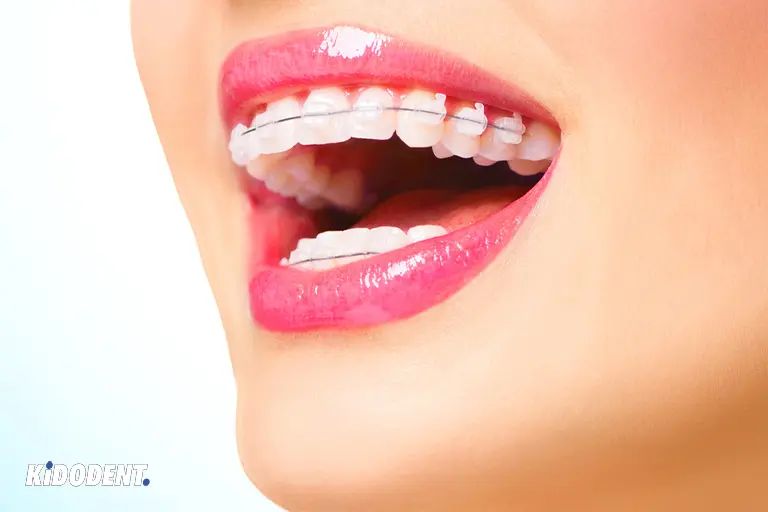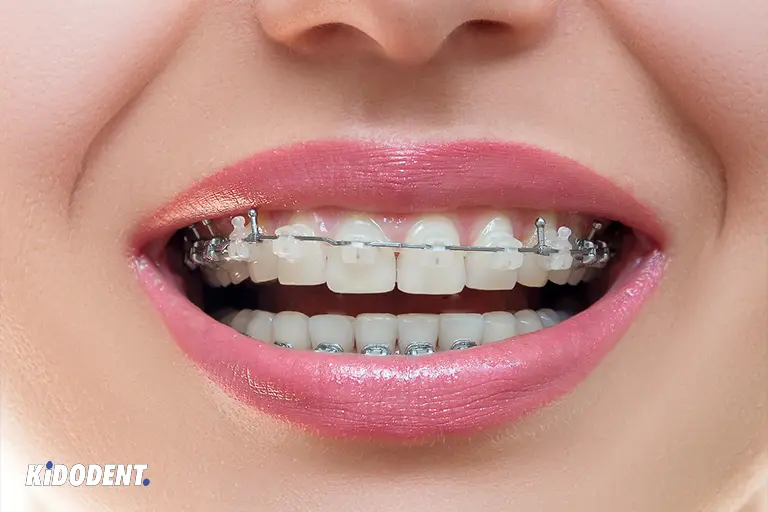More and more people may become self-conscious about wearing traditional metal braces for their orthodontics. They want something that has the same effects as metal braces but with less attention on their teeth during their orthodontic treatment. If you want to straighten your teeth with a less obvious orthodontic appliance, clear ceramic braces are one solution to go for.
What are ceramic braces?
Ceramic braces, also called clear braces, are tooth-colored braces that are used to straighten teeth with less noticeable materials for its brackets. Ceramic braces offer a discreet appearance and correct bite problems, irregularities in teeth and any malocclusion that has impacted your smile. Just as metal braces, the time scale for wearing ceramic braces is similar. You may wear braces for 18-24 months or a few years depending on the dental and jaw problems.
What is the difference between ceramic and metal braces?
Ceramic braces are a type of invisible braces made of alumina crystalline materials, while traditional metal braces are made from stainless steel or other alloys like titanium. It is a good idea to break down the different parts of braces to explain better. Braces have brackets that are attached to the surface of teeth. By ceramic braces, we mean ceramic brackets.
Brackets can have metal slots or other non-metal designs, where the wires are inserted. Both ceramic and metal braces use wire to regulate the force and pressure that is necessary to straighten teeth. Wires are made from stainless steel and sometimes can be coated with white color to eliminate any metal visibility.

Having aligned and straighter teeth improves not only your smile but the overall appearance. Orthodontists have provided a variety of other options like Invisalign clear aligners and lingual braces, which are also popular invisible choices. Most people are aesthetically conscious about wearing metal braces. They don’t want others’ attention on their teeth until at least the results are achieved. Children may wear plastic or ceramic to avoid drawing attention at school. Thus, ceramic brackets were introduced by dentists to prioritize all things for all people.
Apart from the aesthetics, clear braces can have disadvantages, too. To better decide on ceramic braces, let’s shed some light on both the benefits and drawbacks of this innovative orthodontic appliance.
Pros and cons of ceramic braces
Compared to traditional metal braces, there are both advantages and disadvantages to ceramic braces.
Pros
- Less visible.
- ceramic braces are less visible and less noticeable. Ceramic materials offer a clear, tooth-colored or white form of braces, which favor every individual who wants to correct their misaligned and crooked teeth without revealing to others their orthodontics.
- As effective as metal braces but faster than Invisalign.
- Compared to traditional metallic braces, ceramic is just as effective. It can correct severe to mild jaw deformities and tooth malocclusion using elastics and other supplementary appliances that are also incorporated into traditional braces’ designs. But unlike Invisalign clear aligners, ceramic braces achieve the desired form of perfection for your teeth faster.
cons
- Brittle and may break.
- Ceramic braces are more brittle than stainless steel braces, which are tough against pressures and forces. Therefore, compared to metal braces, ceramic is less durable. Breakage especially happens during debonding when ceramic brackets should be removed from the enamel on your teeth. According to studies, one solution to prevent the enamel damage and breaking of ceramic is using laser-assisted debonding techniques.
- Costs.
- Ceramic braces are more expensive than metal braces. You may pay additional money around $1000 or even $2000 more than traditional ones to get yours.teeth
Ceramic braces cost and insurance coverage
The total cost of ceramic braces can vary from $4,000 to $8,000. On the other hand, you will normally expect $3,000-$7,000 price range for the metal braces.
Having insurance coverage for your orthodontic treatment can reduce your costs. Some insurance policies may consider coverage plans if the degree of severity and malocclusion may hinder oral and dental health in children or even in adults. If your dental insurance doesn’t cover orthodontics, you can also benefit from a flexible savings account (FSA) or health savings account (HSA), which can be offered by your workplace or if you have certain standard requirements.
Are ceramic braces durable?
Ceramic braces tend to break more often compared to metal braces, which are a sturdier form of braces type. The breaking of ceramic by harsh contact with teeth or other objects makes them prone to more risks. These issues may cause delays in orthodontics for repairing and readjusting the damaged ceramic components. Your orthodontist may consider metal braces if you:
- Play sports or involve in hard physical work
- Are children or teenagers who are more active
- Are an Individual who have bruxism (grinding teeth during sleep) or habits like nail-biting
Do ceramic braces stain?
Ceramic braces are more stained-resistant if we compare them with plastic braces. On the other hand, they may get stained when your regular diet is full of colored foods and drinks all the time. When you are wearing any form of braces, you need to be a little careful about what to eat. To avoid staining and harming your ceramic brackets, follow the tips below:
- Do not drink or eat high-colored foods and liquids.
-
There are some foods and drinks that can discolor the ceramic surface like wine, berries, grapefruit, coffee, soda, energy drinks, and some high-pigmented sauces or ketchup.
- Avoid crunchy and hard foods.
-
If you are eating fruits, cut them into smaller pieces. Apples, carrots, and other hard-surfaced vegetables or fruits may break off the ceramic components, so be careful about how and what you eat.
- Avoid smoking.
-
Even healthy teeth turn yellow with smoking, let alone the braces. To prevent your ceramic brackets from staining, you shouldn’t smoke. Sounds like a good idea to start quitting!
- Do your brushing and flossing daily.
-
Stick to the everyday brushing and flossing of your teeth. Maintaining good oral health during orthodontics is necessary to prevent cavities, tooth decay, and bacterial growth on teeth and around the braces.
- No whitening toothpastes.
-
If you use whitening toothpastes or other whitening products like gels when your braces are on, the parts of teeth that are under the brackets will maintain their color. Therefore, the exposed teeth appear whiter in color.

Am I the right candidate for ceramic braces?
Any orthodontic treatment can be effective if used for the right person with the right conditions. Invisalign clear aligners, for example, may not be suggested when there is a complex dental and jaw problem. Ceramic braces, too, require healthy enamel on teeth with no cracks or signs of fracture because the ceramic contact on damaged enamel may cause more harm.
When it comes to effectiveness, both metal and ceramic are efficient for treating crooked teeth and bite problems. Adults opt for ceramic ones because they may work outside and have social communications, which metal braces are not acceptable in their mind.
Orthodontists will offer ceramic if you want less visibility of metal on your teeth. On the other side, they may recommend traditional metal braces if aesthetics is not an issue. Sometimes, you can even receive ceramic just for anterior teeth or upper front teeth and the rest of teeth still have metal brackets on.
All in all, the goal is always getting the perfect results. Your orthodontist will help you with every type of brace that can be pleasant and blend in with your appearance.
